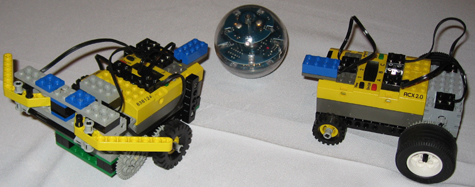Robotics: Is Microsoft's vision the right one?

New Yorkers claim New York City to be the capital of many things: media, arts, fashion…but is the Big Apple also “robot city”?
The New York Software Industry Association (NYSIA) convened a panel of academics, artists and hobbyists last evening to find out. Robots were on hand too.
Farshad Khorrami, Professor, Computer Engineering, Polytechnic
Brian Peek, creator "The Finalizer", first Battle Bot to operate using Microsoft .NET
Eric Singer, Founder, LEMUR (League of Electronic Musical Urban Robots)
Elizabeth Sklar, Professor, Computer Science, Brooklyn College
While noting “you can say what you like about Microsoft,” Bernstein welcomed “the old Bill Gates” industry visionary.
Bernstein underscored Gates’ juxtaposition of the state of the robotics industry today to the computer industry during the mid-1970s, when Gates launched Microsoft with Paul Allen.
Gates on “the emergence of the robotics industry, which is developing in much the same way that the computer business did 30 years ago”:
Think of the manufacturing robots currently used on automobile assembly lines as the equivalent of yesterday's mainframes. The industry's niche products include robotic arms that perform surgery, surveillance robots deployed in Iraq and Afghanistan that dispose of roadside bombs, and domestic robots that vacuum the floor. Electronics companies have made robotic toys that can imitate people or dinosaurs, and hobbyists are anxious to get their hands on the latest version of the Lego robotics system…The challenges facing the robotics industry are similar to those we tackled in computing three decades ago. Robotics companies have no standard operating software that could allow popular application programs to run in a variety of devices. The standardization of robotic processors and other hardware is limited, and very little of the programming code used in one machine can be applied to another. Whenever somebody wants to build a new robot, they usually have to start from square one…. Despite these difficulties, when I talk to people involved in robotics--from university researchers to entrepreneurs, hobbyists and high school students--the level of excitement and expectation reminds me so much of that time when Paul Allen and I looked at the convergence of new technologies and dreamed of the day when a computer would be on every desk and in every home.
Gates cites a “universal enthusiasm for the potential of robotics, along with an industry-wide desire for tools that would make development easier” as the underpinnings for a “technological turning point where a move to PC architecture makes more and more sense.”
For Gates, the turn leads to Microsoft research on “the problem of concurrency” and development in “simplifying the writing of distributed robotic applications through a technology called decentralized software services (DSS)”: Microsoft Robotics Studio.
Is Microsoft blazing a robotics revolution?
Sklar underscored that issues of concurrency and distributed architecture are not new ones, or Microsoft-specific ones. Moreover, she cautioned against the downside of mass standardization.Sklar pointed to the educational risks of making development “easier.”
As founding chair of RoboCupJunior (RCJ), Sklar leads project-oriented educational robotics initiatives worldwide for students up through age 19:
RCJ challenges emphasize cooperative, problem-solving and task-achievement aspects. In the soccer challenge, 2-on-2 teams of autonomous mobile robots play games in a highly dynamic environment, tracking a special light-emitting ball in an enclosed field landmarked in shades of gray…

RCJ's umbrella organization, RoboCup, is an international effort supporting Artificial Intelligence and robotics research by providing a standard problem where a wide range of technologies can be integrated and examined:In contrast to the one-child-one-computer scenario frequently seen today, RCJ provides an opportunity for participants with a variety of interests and strengths to work together as a team to achieve a common goal. The RCJ emphasis on autonomous robots fosters development of computer science and programming skills.
The ultimate goal of RoboCup is that by the middle of the 21st century, a team of fully autonomous humanoid robot soccer players shall play (and win!) a soccer game against the (human) world champions.
For Khorrami, faster development cycles promised by systematic architectures would be welcome in the robotics industry. As Director of the Control Robotics Research Laboratory, Khorrami researches unmanned autonomous vehicles and has developed a working autonomous helicopter.
Singer is always on the lookout for development tools offering the right mix of price point, functionality and ease of use.
As Founder of the LEMUR Brooklyn-based group of artists and technologists who create robotic musical instruments, Singer helps create “exotic, sculptural musical instruments” which integrate robotic technology.
If LEMEUR can’t find the right robotics component, Singer seeks to develop one himself, such as the MidiTron:
MidiTron is a new MIDI to real-world interface designed to simplify the process of creating sensor and robotics based electronic art projects. It is easily user configurable and provides 20 terminals of digital and analog inputs and outputs in any combination. MidiTron is available from Eroktronix for $149.